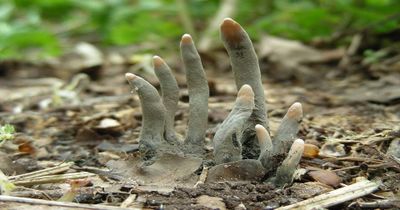Xylaria polymorpha: Difference between revisions
| (2 intermediate revisions by the same user not shown) | |||
| Line 16: | Line 16: | ||
==Description and Significance== | ==Description and Significance== | ||
''X. polymorpha'' is commonly referred to as “Dead man’s fingers” because of the appearance of its fruiting body. The “mushrooms" of ''X. polymorpha'' are cylindrical and covered with a bumpy, carbon-like coating that gives it a dark brown or gray coloration (2,3). Fully matured fruiting bodies can grow up to | ''X. polymorpha'' is commonly referred to as “Dead man’s fingers” because of the appearance of its fruiting body. The “mushrooms" of ''X. polymorpha'' are cylindrical and covered with a bumpy, carbon-like coating that gives it a dark brown or gray coloration (2,3). Fully matured fruiting bodies can grow up to 10 cm tall and often grow out of the soil near decaying trees in “finger-like” clusters of three (3). Its very distinctive morphology makes it relatively easy to identify. | ||
''X. polymorpha'' is primarily a saprobe of wood and is widely distributed throughout deciduous forests in North America and Europe (2). Its ability to decompose wood makes it an important organism for recycling fixed carbon. | ''X. polymorpha'' is primarily a saprobe of wood and is widely distributed throughout deciduous forests in North America and Europe (2). Its ability to decompose wood makes it an important organism for recycling fixed carbon. | ||
[[File:Dead man's fingers fungus.jpg|border|400px]] | |||
==Life Cycle, Cell Structure, Metabolism== | ==Life Cycle, Cell Structure, Metabolism== | ||
| Line 37: | Line 38: | ||
==Ecology and Pathogenesis== | ==Ecology and Pathogenesis== | ||
While ''X. polymorpha'' is primarily a saprobe wood in deciduous forests, if a tree is injured or under stress, it may act as a weak pathogen by entering through a wound. It causes “soft rot” by breaking down the polysaccharides within wood, only leaving behind unconnected | While ''X. polymorpha'' is primarily a saprobe wood in deciduous forests, if a tree is injured or under stress, it may act as a weak pathogen by entering through a wound. It causes “soft rot” by breaking down the polysaccharides within wood, only leaving behind unconnected lignin and cellulose (1,2). | ||
==References== | ==References== | ||
Latest revision as of 19:57, 9 December 2020
Classification
Eukarya; Fungi; Ascomycota; Sordariomycetes; Xylariales; Xylariaceae
Species
|
NCBI: [1] |
Xylaria polymorpha
Dead man's fingers
Description and Significance
X. polymorpha is commonly referred to as “Dead man’s fingers” because of the appearance of its fruiting body. The “mushrooms" of X. polymorpha are cylindrical and covered with a bumpy, carbon-like coating that gives it a dark brown or gray coloration (2,3). Fully matured fruiting bodies can grow up to 10 cm tall and often grow out of the soil near decaying trees in “finger-like” clusters of three (3). Its very distinctive morphology makes it relatively easy to identify.
X. polymorpha is primarily a saprobe of wood and is widely distributed throughout deciduous forests in North America and Europe (2). Its ability to decompose wood makes it an important organism for recycling fixed carbon.
Life Cycle, Cell Structure, Metabolism
Like most ascomycetes, X. polymorpha gains its energy through absorptive nutrition--the process of secreting digestive enzymes that break down complex carbohydrates, allowing the fungus to absorb smaller products for nutrients to fuel growth and reproduction (2).
Sexual fruiting bodies of X. polymorpha tends to develop mid-to-late year, any time from May to November (2). Its sexual spores are found in dark perithecia that are embedded in a white stroma on the interior of the ascocarp (3). The fruiting body is tough and durable, allowing it to persist for months or longer to slowly release spores--a feature uncommon to many fungi (2). The slow release of spores is thought to allow this species to have a large distribution range within its habitat (2).
The asexual structure of X. polymorpha is not long-live and therefore, does not have many of the phenotypes of the sexual structures. The formation of asexual spores leads to a white/gray-ish appearance with a powdery texture from conidia (3).
Its fruiting structures are known to produce diverse classes of bioactive secondary metabolites, including several antifungal metabolites. Some examples are multiploides A and B, polypropionates, and xylarinic acid A and B (4).
Genome Structure
X. polymorpha contains a 43.52 MB genome, 48.5% GC content, 951 contigs, 74,443 contig N50, 174 contig L50, 947 scaffolds, 74,858 scaffold N50, and 173 scaffold L50 (5,6).
Ecology and Pathogenesis
While X. polymorpha is primarily a saprobe wood in deciduous forests, if a tree is injured or under stress, it may act as a weak pathogen by entering through a wound. It causes “soft rot” by breaking down the polysaccharides within wood, only leaving behind unconnected lignin and cellulose (1,2).
References
[1] Schoch CL, et al. NCBI Taxonomy: a comprehensive update on curation, resources and tools. Database (Oxford). 2020: baaa062. https://www.ncbi.nlm.nih.gov/Taxonomy/Browser/wwwtax.cgi?mode=Info&id=77046
[2] Vogini, J. & Powell, S. (2001). The Virtual Nature Trail at Penn State New Kensington, Species Pages. The Pennsylvania State University. https://www.dept.psu.edu/nkbiology/naturetrail/speciespages/deadmansfingers.htm
[3] Emberger, G. (2008). Xylaria polymorpha. Messiah College. https://www.messiah.edu/Oakes/fungi_on_wood/club%20and%20coral/species%20pages/Xylaria%20polymorpha.htm
[4] Jang, Y. W., Lee, I. K., Kim, Y. S., Seok, S. J., Yu, S. H., & Yun, B. S. (2009). Chemical Constituents of the Fruiting Body of Xylaria polymorpha. Mycobiology, 37(3), 207–210. https://doi.org/10.4489/MYCO.2009.37.3.207. https://www.ncbi.nlm.nih.gov/pmc/articles/PMC3749389/
[5] NCBI: 71616. https://www.ncbi.nlm.nih.gov/genome/?term=txid77046[Organism:noexp]
[6] ASM342623v1. https://www.ncbi.nlm.nih.gov/assembly/GCA_003426235.1/#/st
Author
Page authored by Cadence J Flohrschutz, student of Dr. Marc Orbach, University of Arizona .

